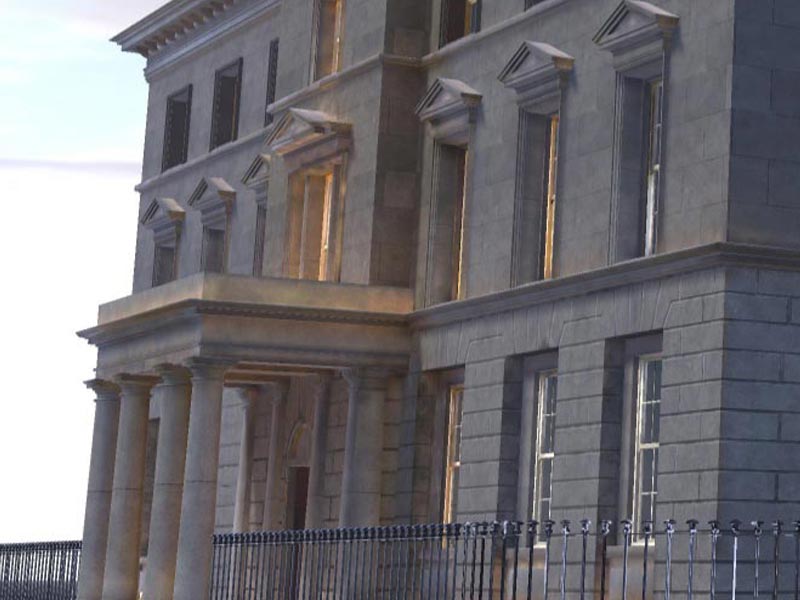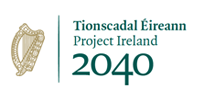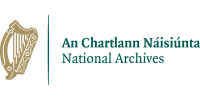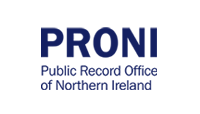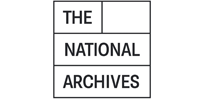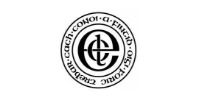

Medieval Exchequer
Delving Deeper
These pages provide detailed descriptions of the documents in the Gold Seam, together with historical background and archival context. The information here is aimed at all researchers who want to delve deeper into these fascinating collections.
Historical Background
The Irish exchequer was one of the first institutions of English government in Ireland, which developed in the years after the invasion of 1169. By 1200, we find early references to the treasurer of Ireland, who was responsible for money collected and spent by the king’s officials across the lordship.
Over the centuries the Irish exchequer grew, gaining new officials and new responsibilities, but always maintaining its core focus as the financial office of the lordship. For most of its existence, the exchequer was based in and around Dublin castle, barring a brief period in the fourteenth century when it transferred to Carlow.
As one of two major institutions of English administration in Ireland (the other being the chancery, or royal writing office), it played an important role in maintaining English control over the lordship. The exchequer was responsible for all money collected for the king within Ireland, which included rents, taxes, fines, court-fees, and more. It was also responsible for payments owed to the king’s subjects in Ireland. Horses, for instance, were regularly purchased or rented for official use. We also find payments for wine, wages, and weirs, or for food and supplies to be sent elsewhere in the English king’s territories, particularly for war in Wales and Scotland. All of this was documented in parchment rolls written in Latin by the exchequer’s clerks.
In practice, the exchequer’s financial system operated using coins and other goods. Most payments into or out of the exchequer used silver coins, from the smallest farthing to the largest pound. The most common coin was the silver penny, either minted in Ireland or brought across from England. A few payments (particularly those from Gaelic Irish kings) were even made in cows. The exchequer used an exchange rate of ten cows to a pound when recording these payments in their accounts. Some rent payments were also made in unusual ways. The royal manor of Lucan near Dublin traditionally paid its rent in pairs of furred gloves, and elsewhere we find rents paid in hunting hawks and drums. The exchequer probably sold these rents; it did not issue similar payments in kind but used only cash.
Payments into the Irish exchequer came from men and women at all levels of society. Small payments, like fines paid by business women for cheating their customers, are recorded alongside large payments, like those made by wealthy heiresses to secure their lands and rights. Gaelic Irish lords, Italian bankers, and Welsh mercenaries appear alongside the merchants, townsmen, and tenants of the lordship. These payments allow us to glimpse family feuds and factional conflict, yet also reveal networks and cooperation in medieval Irish society, with individuals working together to support lawsuits or to transport payments across long distances.
A series of corruption scandals in the Irish exchequer in the 1280s and 1290s led to changes in its working practices, but also (fortunately) to the very records which now tell us about its activities. On one occasion, officials complained that the treasurer was stealing money and mishandling payments. An investigation found that the treasurer had indeed been taking large sums from the king’s revenues – over £12,000 (approximately £500 million in current values!) At this point, by comparison, the entire income of the exchequer yearly was about £3,000.
As a result, a new system was created: the accounts of the Irish exchequer would be transported to London and checked by the king’s clerks in Westminster. At the end of the audit, copies of the records were kept in both places. Fortunately, the copies kept in London mostly survived the centuries, unlike the vast majority of their counterparts in Dublin. These London records now form the basis of the Medieval Exchequer Gold Seam.

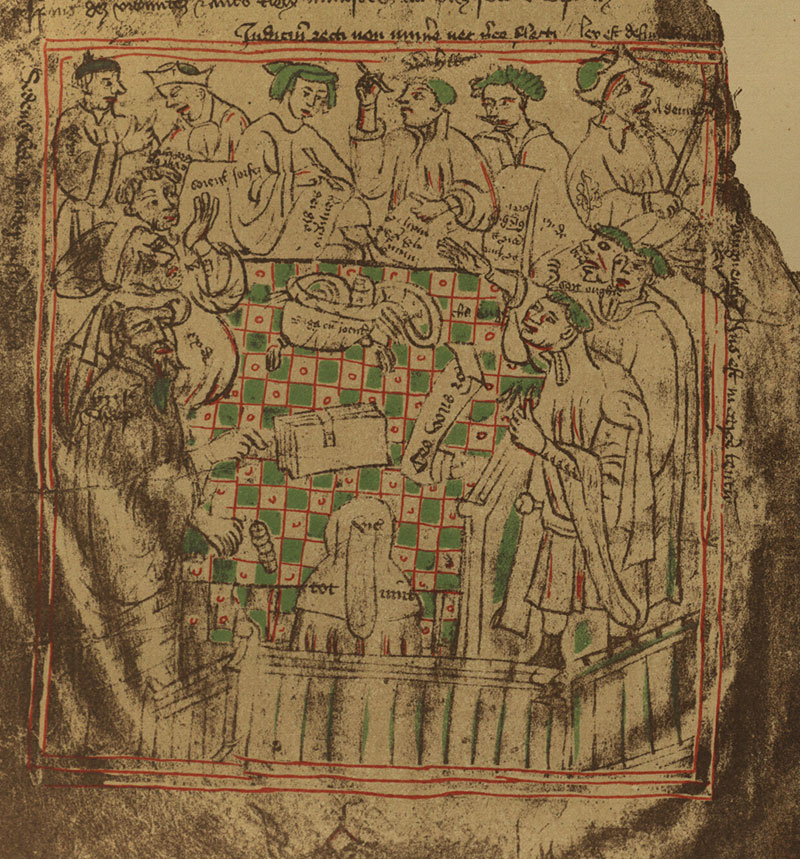

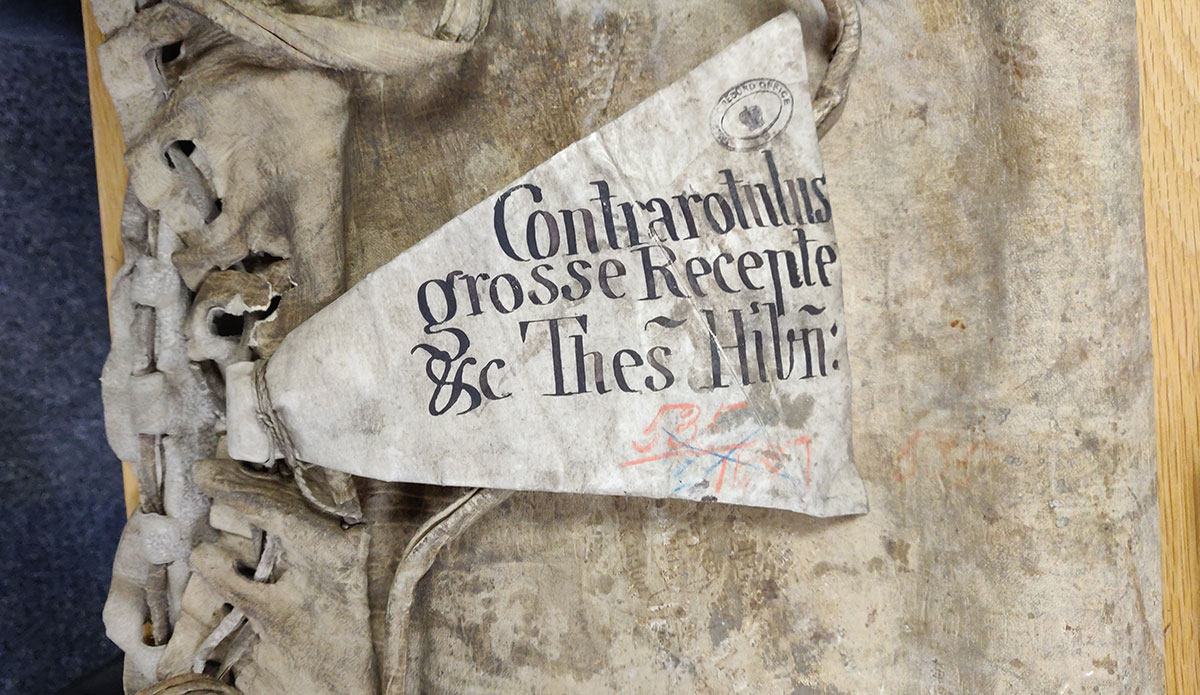




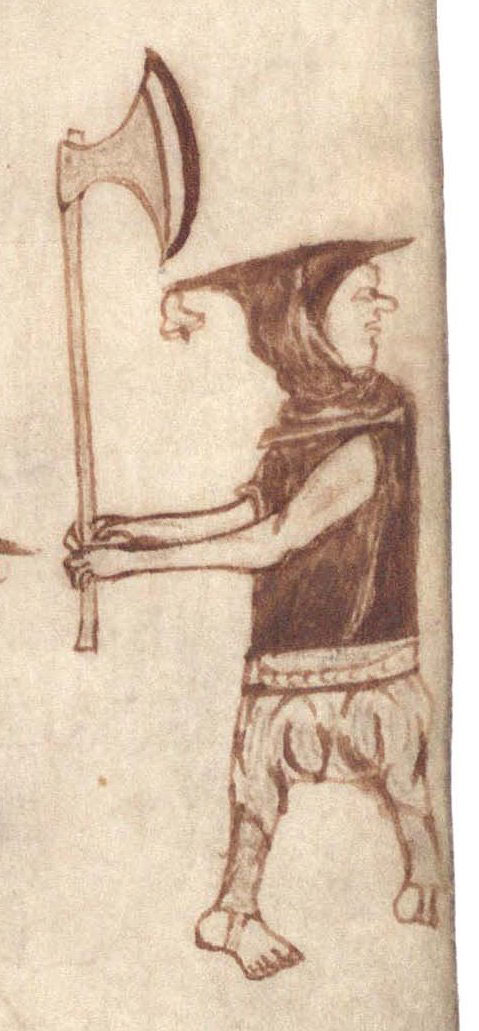
Manuscripts and Replacements
The Four Courts fire of 1922 destroyed all the surviving records of the medieval Irish exchequer, other than two parchment memoranda rolls from the fourteenth century. Luckily, owing to a series of scandals which led to the establishment of a medieval audit process, a shadow archive of medieval originals had been built up in London. These documents are now stored at The National Archives (UK). Additionally, over the years historians and antiquarians made calendars and extracts from the PROI items. These various sources are summarised below.
Receipt Rolls of the Irish Exchequer (The National Archives (UK), E 101)
Membranes of parchment (animal skins, often sheep or goat) are cut and prepared for writing. The rolls are formed of individual membranes sewn at the head and foot before being rolled up. Arranged in chronological order following the exchequer year (30 September – 29 September) they record the king’s financial dealings. Receipt rolls record payments made into the lower exchequer by royal officials and others. Payments might arise as part of the legal and financial processes in the shires and liberties of Ireland, or as transfers of revenue between Westminster and Dublin. Payments relating to the administration and management of land, inheritance, taxation, trade, and commerce and the military also appear.
Recorded receipts are laid out entry-by-entry, often line-by-line and running from left to right. The date is usually written in the centre of the membrane (not every date has payments , for example no business took place on a feast-day). A note in the left margin gives a short reference either to the county, liberty, official, or nature of receipt concerned (for example Dublin, Wexford, keeper of customs, receipts from royal taxation). The main body of the entry details the sums received, from whom and for what reason; the amount is shown separately in the right margin. Daily and weekly sum totals are given in the right margin. Sum totals for the whole roll are usually written on the final membrane. These rolls were drawn up in triplicate in the Irish exchequer. The surviving rolls are generally those of the second chamberlain, a senior official, which were despatched to Westminster as part of the audit process for the accounts of the treasurers of the Irish exchequer from the 1270s.
Digital images and a new edition from this series for the period 1270 to 1315 are now available.
Issue Rolls of the Irish Exchequer (The National Archives (UK), E 101)
Also arranged in chronological order following the exchequer year, the Issue Rolls record payments out of the lower exchequer made to private individuals, royal officials, military captains and other grantees for a vast array of purposes associated with the English royal government of Ireland.
Payments are arranged in the format found on the Receipt Rolls (above), with each transaction set out on a separate line, the date in the centre of the membrane, identifying details in the left margin, a description of the reason for the payment in the centre, and the amount and sum totals in the right margin. Here too the sum totals for the whole roll are usually written on the final membrane.
Following the process for the Receipt Rolls, the Issue Rolls were also drawn up in triplicate in the Irish exchequer. The surviving rolls are those of the second chamberlain, dispatched to Westminster for auditing. Issue rolls have been edited in English calendar (short summaries) form by Dr Philomena Connolly in Irish Exchequer Payments, 1270–1449 (Dublin: Irish Manuscripts Commission, 1998).
Images from the original manuscripts and the printed calendar by Philomena Connolly are now available and interlinked here.
Supplementary writs and receipts (The National Archives (UK), E 101)
As part of the accounting process in the lower exchequer, accountants submitted a range of documentation essential to the proper audit of their accounts and their own acquittal from outstanding debts. These documents came from the chancery or exchequer (Dublin and/or Westminster) and recorded orders to receive or spend money for various reasons, and numerous other associated instructions. Supplementary writs and receipts were usually written on thin strips of parchment to which a small wax seal was attached, as authority for the transaction. Some writs and receipts still have their seals attached, though usually only fragments of wax survive.
They are drafted in a form different from the Receipt and Issue Rolls above. Each writ or receipt begins with a formulaic address to the recipient, followed by instructions. They often recount previous instructions that are now being countermanded, altered or reinforced. This is followed by a sealing clause to reinforce the authority imbued within the royal seal and, finally, witness and dating clauses giving personal authority for the order and a date and place at which it was issued.
On the reverse (or dorse) are written replies from the officials to whom the order is addressed and additional process notes as the account was signed off. These subsidiary records were drawn up either in Ireland or England, the surviving ones are those sent to Westminster as part of the process of new audit procedure following the scandals of the 1270s and 1280s.
A small sample of digitised writs and receipts is available here.
Enrolled accounts of the Treasurer of the Irish Exchequer (The National Archives (UK), E 352, E 364, E 372)
The final documentation of the audit process at Westminster to survive are the large ‘enrolled’ accounts of the English exchequer, which recorded the final, fair-copy audited accounts of the treasurer of the Irish exchequer. Up to the first half of the fourteenth century these were largely recorded on the Pipe Rolls (series E 372; copies on the Chancellor’s Rolls, series E 352). Thereafter, they appear with other business deemed to be ‘foreign’ to usual business of English shire administration and government finance, on the ‘Foreign Account Rolls’ (E 364).
The arrangement of these membranes was different. Individual rotulets (one or more membranes sewn head and foot) were sewn together only at the head, like a modern flipchart. Accounts of the Irish exchequer can appear on either side and at any position on a particular rotulet, or series of rotulets. It is not usual for them to cover one single rotulet on their own. They begin with a heading, laying out the account and relevant reporting period. The receipts and issues are then drafted in separate sections, each payment following the next (not on a separate line) before a sum total of receipts, then a total of payments issued and finally a sum-total at the end of the account.
These documents are listed here. Where they were used in Connolly’s edition of the issue rolls, they are interlinked there.
Memoranda Rolls of the Irish Exchequer (including National Archives Ireland, EX 1, RC 7 & RC 8; Ferns Diocesan Archives, Wexford.)
Only two original parchment rolls survive at the National Archives (Ireland); the remainder survive in over fifty volumes of transcripts made by the nineteenth-century Irish Record Commission. In addition, local historians made extracts from the memoranda rolls. During the audit process in the upper exchequer in Dublin, memoranda were taken that record the progress of business with individual accountants or debtors at the exchequer. These are much longer entries in nature and, while formally structured, can diverge in formulae and content.
James Lydon summarised the surviving material from the memoranda rolls in Analecta Hibernica here. The metadata in the Virtual Record Treasury’s database can be searched here.
Editorial Conventions for Receipt Rolls
This digital edition presents translations of the receipt rolls of the medieval Irish exchequer, which have been encoded in TEI-XML text files. TEI, the Text Encoding Initiative, provides an international standard for the representation of texts in digital form by libraries, museums, publishers and scholars across the world.
The guiding principle is to make this edition of the accounts of the medieval Irish exchequer (and other medieval records in the Virtual Record Treasury) as intelligible as possible to as wide an audience as possible. Due to their generally brief, formulaic nature, the records are directly translated into modern English without losing the literal, technical sense of the original language, which is almost exclusively Latin.
In cases where the manuscript is damaged or faded, text supplied by the editors is given within square brackets. Where the original Latin phraseology is important, unusual, or difficult, this is supplied within round brackets. A list of common phrases is given below.
These editorial conventions apply to the edition of the receipt rolls created for the Virtual Treasury. Philomena Connolly used slightly different conventions for the issue rolls.
Both issue rolls’ calendars and the receipt rolls’ translations have each been given reference codes within the medieval exchequer gold seam in the Virtual Treasury. Each item has been numbered by the year it starts and where there are more than one roll with the same starting year, it has been distinguished in date order by a letter.
An issue roll’s reference will look like this VRTI MedEx 1/1/1270.
A receipt roll’s reference will look like this: VRTI MedEx 1/2/1307/a, where 1307 indicates the year the roll began and a indicates that it is the first roll surviving from that year. The translations of the receipt rolls remain drafts and subject to change. Work to integrate them with the Knowledge Graph for Irish History is ongoing.
Names
Christian names are extended and modernised as per the Oxford English Dictionary and Dictionary of Irish Biography, so ‘Ralph’ for ‘Rad[ulphu]s’, ‘William’ for ‘Will[elmu]s’, ‘Gilbert’ for ‘Gil[ebertus]’ and ‘Donnchadh’ for ‘Donatus’. However, they are not extended if there is no clear indication within the text of the full form, or if the individual cannot be securely identified. So, ‘H.’, not ‘Hubert’ or ‘H[ubert]’, but H[ugh], bishop of Meath, where that individual is known. Where a modern form is unclear, the original is retained. Unusual or obsolete names, or unusual renderings of more common names, are maintained. Irish names are left as recorded by the exchequer clerks.
Occupational surnames are modernised, so ‘Clericus’ becomes ‘Clerk’, and ‘Pistor’ becomes ‘Baker’, but the Latin is also given. Nickname surnames in Latin or French will be translated directly into English. ‘Ruffus’ and ‘le Rous’ are, for instance, to be translated into English as ‘Red’, while ‘Lupus’ becomes ‘Wolf’. However, Irish distinctions such as ‘Og’ or ‘Mor’ are retained. Finally, and more straightforwardly, patronymic surnames such as ‘Johannes filius Roberti’ are translated simply as ‘X son of Y’, so ‘John son of Robert’.
Placenames
All place names which can reasonably be identified are modernised, including those that form a surname. The original forms of place names are preserved as notes in round brackets. ‘De’ is retained in surnames, unless this contradicts a standard usage.
Standard Phrases
| Latin Phrase | Standard Translation |
| ad paciendum inquisitionem | to settle the inquisition |
| ad terminum | for re-entry at the end of a lease |
| brevia de ingressu | writ of entry into lands |
| catalla felon’ for’ | Chattels of (a) forfeited felon(s)
[‘Chattels’: property other than land] |
| Drogheda ex parte Mid’ / Uriel’ | Drogheda on the side of (Meath or Uriel) |
| esse quietus | to be released |
| fine pro recept’ | fine for receiving |
| maritagium | marriage portion |
| placita et perquisitia curie | pleas and perquisites of the court |
| pro certificatione capienda | for taking a certification |
| pro certificatione habenda | to have a guarantee |
| pro def[ec]tu in magna assisa | default in the great assize |
| pro deforciamento | for forcing a rightful owner out of their lands |
| pro evasione | for an escape / the escape of |
| pro falso clamore | for a false claim |
| pro fine pro redemptione pro terris et catallis suis rehabendis | for a fine to redeem and have back his lands and chattels |
| pro iniusta detentione | for unjust detention |
| pro intrusione | for intruding [into another’s lands] |
| pro lege anglicana habendum | to have [access to] english law |
| pro licencia concordandi | for licence to make concord |
| pro licencia perquirere melius brevi | for licence to purchase a better writ |
| pro licencia recedendi brevi suo | for licence to withdraw from her/his writ |
| pro periurio attincto | for being attainted for perjury
[Attainted: removal of civil rights, property and titles.] |
| pro pluribus transgressionibus per ipsum factis contra pacem | for many trespasses s/he committed against the peace |
| pro prisona et redemptione relevio | for release from prison and ransom |
| pro quod brevia habenda ad certum diem | to have a certain writ on a fixed day |
| pro quod brevia warrantiae chartae habenda | to have a certain writ of warranty of charter |
| pro recto relevio | for release from judgement |
| pro recto relaxando | for release of judgement |
| pro relevio suo | for her/his relief |
| pro retto relicto | for abandoning a charge |
| pro secta domini regis remittendi | for having the king’s suit [against her/him] remitted |
| quia attachiatus non venit | who did not come when attached |
| quia attinct’ de falso sacramento | because s/he is attainted by a false oath |
| quia convicti super falsam sacramentam | because s/he/they was/were convicted for a false oath |
| quia falso presentavit | because s/he falsely presented |
| quia minus bene executus fuit officium suum | because he carried out his office less well |
| quia non est prosecutus/prosecuta | because s/he did not prosecute |
| quia non habet x quem manucaptuavit | because s/he did not have x whom he had mainperned
[Mainperned: stood bail for] |
| quia summonitus/summonita non venit | because s/he did not come when summoned |
| rettatus | charged with |
| sicut habuit diem de banco | as s/he had a day to be at the bench [i.e. to appear at the bench of one of the law courts] |
| wreccum maris | wreck of the sea |
Team and Acknowledgements
The project team for this Gold Seam was led by Dr Peter Crooks of Trinity College Dublin (Principal Investigator) and Dr Paul Dryburgh of The National Archives (UK) (Co-Investigator).
The Medieval Gold Seam Research Fellows are Dr Elizabeth Biggs and Dr Lynn Kilgallon, who conducted primary research on manuscripts, translated the receipt rolls, and developed the medieval component of the Knowledge Graph for Irish History.
The translations of the issue rolls were completed by the late Dr Philomena Connolly of the National Archives (Ireland) for the Irish Manuscripts Commission.
Professor Brendan Smith and Mike Jones from the University of Bristol advised on the new translations, data analytics and developed the TEI-XML schema used in this Gold Seam.
Zoe Reid of National Archives (Ireland) and Project Conservator Jessica Baldwin conserved the original parchment rolls at National Archives (Ireland).
The Digitisation Team at The National Archives (UK), Andre Santos and Billy Mahoney digitised the original parchment rolls and files at the National Archives (UK). These records were conserved by the Collections Care team.
Dr Áine Foley catalogued the Hore MSS at Ferns Diocesan Archive. We are grateful to Rev. Jim Hammell for generously providing digital access to this invaluable corpus of transcriptions and rare facsimiles.
Independent researcher Randolph Jones generously contributed his own transcriptions from the calendars of Irish memoranda roll material now in the College of Arms, London.
Professor Robin Frame and Dr Beth Hartland of the English Landholding Project at Durham University generously provided access to their database of Irish place-names.

